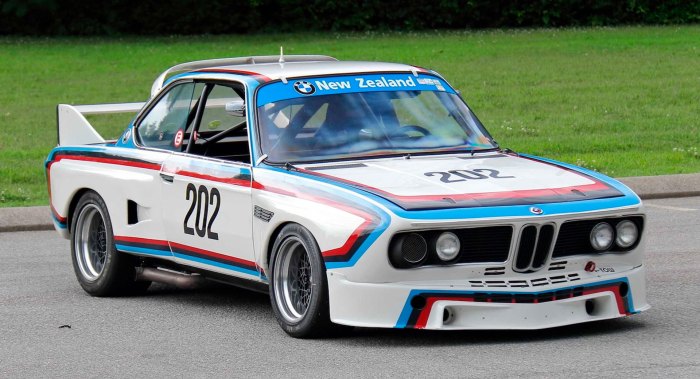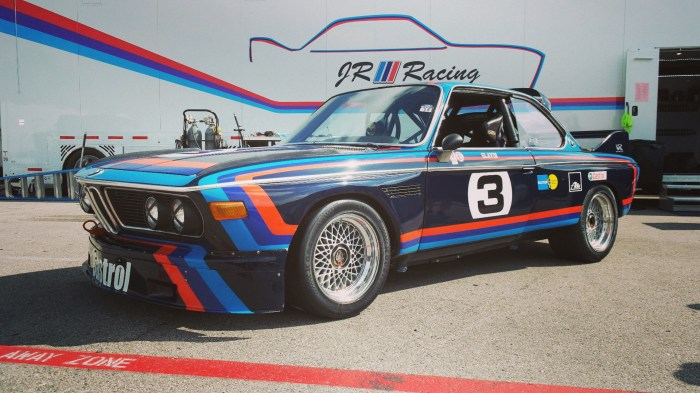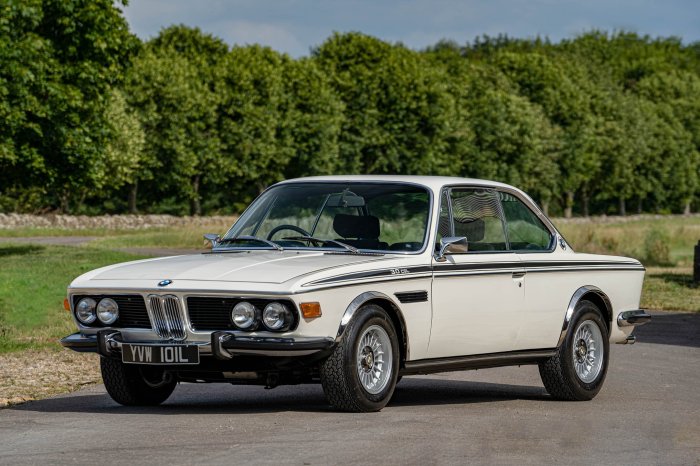1972 BMW 3.0CSL, a name that evokes images of sleek, powerful machines dominating racetracks and captivating enthusiasts. This iconic coupe, born from BMW’s motorsport ambitions, transcended the realm of mere automobiles, becoming a symbol of performance and innovation that continues to resonate today.
The 3.0CSL was not merely a car; it was a statement, a testament to BMW’s dedication to pushing the boundaries of engineering and design.
The 3.0CSL was a product of a time when motorsport and road car development went hand-in-hand. BMW’s racing program, particularly in the European Touring Car Championship, spurred the development of the 3.0CSL, a car meticulously engineered for both speed and endurance.
It was a machine that captured the spirit of the era, a time when motorsport was at the forefront of automotive innovation.
Introduction

The BMW 3.0 CSL, a high-performance coupe that debuted in 1971, is a legendary model in the automotive world, known for its iconic design, racing heritage, and engineering excellence. The car’s origins trace back to BMW’s desire to create a homologation special, a street-legal version of their racing car, the 3.0CS, to compete in the European Touring Car Championship.
This move allowed BMW to exploit loopholes in racing regulations, which favored cars with a minimum production run.The 3.0 CSL quickly became a symbol of BMW’s motorsport prowess, winning numerous championships and achieving legendary status on the racetrack. Its success significantly contributed to BMW’s growing reputation for performance and innovation, establishing a strong foundation for the brand’s future motorsport legacy.
Impact on BMW’s Motorsport Legacy
The 3.0 CSL’s impact on BMW’s motorsport legacy is undeniable. Its racing success, especially in the European Touring Car Championship, solidified BMW’s position as a dominant force in the world of motorsport. The car’s victories and the subsequent development of the “Batmobile” version, with its distinctive rear wing and aerodynamic enhancements, cemented BMW’s reputation for engineering excellence and performance.
The 3.0 CSL’s success also influenced BMW’s future motorsport endeavors. The model’s racing heritage inspired the development of other iconic performance models, such as the M3, which went on to achieve similar success in various motorsport disciplines. The 3.0 CSL’s influence can be seen in the DNA of BMW’s M division, which continues to produce high-performance vehicles that excel both on the track and on the road.
Design and Engineering

The 3.0 CSL was not just a performance car; it was a testament to BMW’s engineering prowess and a symbol of the brand’s commitment to motorsport. The car’s design was a masterpiece of lightweight construction and aerodynamic efficiency, pushing the boundaries of automotive technology in the early 1970s.
The 1972 BMW 3.0CSL, a homologation special built for racing, remains a coveted collectible for its lightweight construction, powerful engine, and stunning design. It’s a prime example of the timeless appeal of classic cars , which continue to captivate enthusiasts with their history, craftsmanship, and driving experience.
The 3.0CSL’s legacy lives on, reminding us of the golden age of motorsport and the enduring allure of these automotive masterpieces.
Lightweight Materials
The 3.0 CSL was built with a focus on minimizing weight, which was crucial for achieving optimal performance on the racetrack. To achieve this, BMW employed a variety of lightweight materials in its construction.
The 1972 BMW 3.0CSL, a legendary homologation special, embodies the spirit of motorsport, just as the 1952 Bentley 4-1/2 Litre, a classic reborn, 1952 Bentley 4-1/2 Litre: A Classic Reborn , embodies the spirit of luxury touring. Both cars represent a bygone era of automotive craftsmanship and performance, reminding us of the timeless allure of classic vehicles.
- Aluminum:The 3.0 CSL’s body panels were crafted from aluminum, significantly reducing weight compared to traditional steel panels. This material choice allowed for a lighter and more agile car, enhancing its handling and acceleration.
- Fiberglass:The 3.0 CSL’s front and rear spoilers, as well as its iconic “ducktail” rear spoiler, were made from fiberglass. This material provided a lightweight and durable solution for aerodynamic enhancements.
- Plastic:BMW used plastic for various components, including the dashboard and interior trim. This helped reduce weight and improve cost-effectiveness.
Aerodynamics
The 3.0 CSL’s aerodynamic design was a key factor in its performance.
- Front Spoiler:The front spoiler, designed with a distinctive “lip,” helped to reduce lift and improve downforce at high speeds, enhancing stability and cornering performance.
- Rear Spoiler:The 3.0 CSL’s iconic “ducktail” rear spoiler was more than just a stylistic element. It was designed to generate downforce, improving traction and stability at high speeds, especially during braking.
- Streamlined Bodywork:The 3.0 CSL’s bodywork was carefully sculpted to minimize air resistance, allowing the car to slice through the air with greater efficiency. This reduced drag, improving fuel economy and top speed.
Performance and Handling: 1972 BMW 3.0CSL

The 3.0 CSL was a technological marvel, designed to be a formidable competitor on the racetrack and the road. Its performance capabilities were a direct result of the meticulous engineering and lightweight construction that defined the car.
Engine Specifications and Performance
The 3.0CSL was powered by a 3.0-liter, inline-six engine, a development of the engine found in the standard 3.0CS. This engine was meticulously tuned to deliver maximum power and responsiveness.
- Power output:The engine produced a remarkable 206 horsepower (153 kW) in its initial iteration. Later iterations, with larger carburetors and a higher compression ratio, saw power increase to 240 horsepower (179 kW).
- Torque:The engine’s peak torque was rated at 202 lb-ft (274 Nm), providing ample pulling power for both everyday driving and spirited performance.
- Weight reduction:To enhance performance, the 3.0CSL underwent extensive weight reduction measures. These included the use of lightweight materials such as aluminum for the hood, doors, and trunk lid, as well as the removal of unnecessary components like sound deadening and the rear seats.
The 3.0CSL’s power-to-weight ratio was exceptional for its time, allowing it to accelerate from 0 to 60 mph in under 7 seconds. This performance, coupled with its precise handling, made the 3.0CSL a formidable competitor in motorsport.
Handling Characteristics
The 3.0CSL’s handling was praised for its precision and responsiveness.
- Suspension:The car featured a sophisticated independent suspension system with MacPherson struts in the front and a semi-trailing arm setup in the rear. This suspension design provided a balance of comfort and control, allowing the car to handle with agility and precision.
- Steering:The 3.0CSL’s steering was known for its sharp and accurate response, providing drivers with a direct connection to the road. This precise steering allowed for precise control, especially in tight corners and on winding roads.
- Weight distribution:The 3.0CSL’s near-perfect 50/50 weight distribution further enhanced its handling characteristics. This balance ensured that the car remained stable and predictable even when pushed hard through corners.
Compared to its contemporaries, such as the Porsche 911 and the Alfa Romeo GTV, the 3.0CSL offered a unique blend of handling characteristics. It was considered more refined and comfortable than the 911, while still delivering a level of performance that rivaled the Italian sports car.
Suspension and Brakes
The 3.0CSL’s suspension and braking systems were integral to its overall performance.
- Suspension:The car’s suspension was tuned to provide a balance between comfort and performance. It was stiff enough to control body roll during spirited driving, yet compliant enough to absorb bumps and imperfections in the road. The suspension was also adjustable, allowing drivers to fine-tune the car’s handling to suit their preferences or the demands of the track.
- Brakes:The 3.0CSL was equipped with powerful disc brakes on all four wheels. These brakes provided exceptional stopping power, allowing the car to slow down quickly and safely from high speeds. The braking system was also designed to be fade-resistant, ensuring consistent performance even after repeated hard braking.
The 3.0CSL’s suspension and brakes played a crucial role in its overall performance, providing drivers with the confidence to push the car to its limits. The combination of these features allowed the car to handle with precision, stop quickly, and deliver a thrilling driving experience.
Motorsport Legacy

The BMW 3.0 CSL, born from the homologation requirements of Group 2 touring car racing, was destined for greatness on the track. It was designed to dominate the European Touring Car Championship and became a legend in its own right, leaving an indelible mark on motorsport history.
The 3.0 CSL’s Competitive History
The 3.0 CSL’s competitive journey began in 1971, with its debut in the European Touring Car Championship. The car quickly established itself as a formidable force, thanks to its lightweight construction, powerful engine, and advanced aerodynamics. The 3.0 CSL’s victories in the European Touring Car Championship were numerous and spanned several years, solidifying its reputation as a racing icon.
Notable Victories and Achievements
The 3.0 CSL’s success in motorsport is not limited to the European Touring Car Championship. It also achieved remarkable victories in other prestigious races, further cementing its legacy.
- 12 Hours of Sebring (1975 & 1976):The 3.0 CSL secured back-to-back victories at the 12 Hours of Sebring, a grueling endurance race known for its demanding conditions and high level of competition. These victories showcased the car’s exceptional reliability and performance capabilities.
- 24 Hours of Daytona (1975 & 1976):In addition to its Sebring triumphs, the 3.0 CSL also dominated the 24 Hours of Daytona, winning the race in 1975 and 1976. These victories highlighted the car’s exceptional endurance and ability to withstand the rigors of long-distance racing.
- German Touring Car Championship (DTM):The 3.0 CSL’s success extended beyond international races, as it also achieved significant victories in the German Touring Car Championship (DTM). Its dominance in the DTM demonstrated its versatility and ability to perform at the highest levels of motorsport.
Impact on Future BMW Racing Cars
The 3.0 CSL’s success was not just about winning races; it was about pushing the boundaries of automotive technology and engineering. The lessons learned from the 3.0 CSL’s development and racing career had a profound impact on future BMW racing cars.
- Lightweight Construction:The 3.0 CSL’s lightweight design, achieved through the use of aluminum and fiberglass, became a cornerstone of BMW’s motorsport philosophy. Subsequent racing cars, such as the M1 and the M3, adopted similar lightweight construction techniques, emphasizing the importance of weight reduction for improved performance and handling.
The 1972 BMW 3.0CSL, a masterpiece of motorsport and engineering, stands as a testament to German precision and performance. While the CSL epitomizes European driving dynamics, its sleek lines and aerodynamic design hint at a different era, one that prioritized opulent luxury, like the 1938 Packard Limousine: A Glimpse into American Luxury.
The Packard, a symbol of American automotive prowess, offered an unparalleled level of comfort and opulence, showcasing the contrasting priorities of two distinct automotive cultures. The 3.0CSL, however, prioritizes driving engagement and precision, a philosophy that has defined BMW’s legacy ever since.
- Aerodynamic Design:The 3.0 CSL’s innovative aerodynamic features, including its distinctive “batmobile” wing, paved the way for future BMW racing cars with advanced aerodynamics. The M3, for example, inherited the 3.0 CSL’s focus on downforce and wind resistance, resulting in a car that was both fast and stable.
- Engine Technology:The 3.0 CSL’s powerful and reliable engine, developed specifically for racing, set a benchmark for future BMW motorsport engines. The M3’s high-revving, naturally aspirated engine, for example, was a direct descendant of the 3.0 CSL’s powerplant, showcasing the legacy of innovation and performance.
Cultural Influence

The 3.0 CSL transcended its role as a race car and became a cultural icon, influencing automotive design and popular culture in ways that continue to resonate today. Its sleek, purposeful lines and legendary performance cemented its status as a symbol of automotive excellence and a coveted collector’s item.
Popularity and Presence in Popular Media, 1972 BMW 3.0CSL
The 3.0 CSL’s popularity is undeniable, evident in its frequent appearances in popular media. Its sleek lines and iconic status have made it a sought-after prop in films, television shows, and video games. For example, the 3.0 CSL was featured in the 1974 film “The French Connection,” showcasing its agility and performance in a thrilling car chase scene.
This appearance, along with others in films like “The Italian Job” and “The Cannonball Run,” helped solidify the 3.0 CSL’s status as a symbol of cool and sophistication.The 3.0 CSL’s popularity extends beyond the silver screen. It has been featured in numerous magazines and books, and its iconic design has been referenced in various forms of art, from paintings and sculptures to fashion and music.
The car’s distinctive design and motorsport legacy have made it a timeless symbol of automotive excellence, capturing the imaginations of car enthusiasts and cultural influencers alike.
The 1972 BMW 3.0CSL, a homologation special designed for motorsport, is a testament to the brand’s commitment to performance. While its sleek lines and powerful engine are undeniable, the car’s legacy is also intertwined with the rugged spirit of off-roading, as exemplified by the 1965 Land Rover Lightweight: A Military Icon.
Both vehicles share a common thread: they were built to push boundaries, whether it be on the racetrack or in the unforgiving terrain of war. The 3.0CSL, like the Lightweight Land Rover, embodies a spirit of adventure and innovation, leaving a lasting mark on automotive history.
Collector’s Value

The 3.0 CSL, a limited-production, homologation special, has become a highly sought-after collectible car, its value steadily climbing over the years. Its rarity, performance, and motorsport legacy all contribute to its status as a prized possession for automotive enthusiasts and investors alike.
Market Value and Trends
The 3.0 CSL’s market value has experienced a significant upward trajectory in recent years. Prices have steadily increased, reflecting the car’s growing desirability and limited supply. The most desirable examples, particularly those with original specifications and a well-documented history, command top dollar.
For example, a 1973 3.0 CSL in pristine condition sold for over $1 million at a 2022 auction.
Factors Contributing to Collectible Status
Several factors contribute to the 3.0 CSL’s collectible status. These include:
- Rarity:The 3.0 CSL was produced in limited numbers, with only 1,265 examples built between 1971 and 1975. This limited production run makes the car highly sought after by collectors.
- Performance:The 3.0 CSL was a technological marvel for its time, boasting a powerful engine, lightweight construction, and advanced aerodynamics. Its exceptional performance on the track and on the road further enhances its desirability.
- Motorsport Legacy:The 3.0 CSL achieved significant success in motorsport, particularly in the European Touring Car Championship. Its victories and dominance in the racing world solidified its reputation as a high-performance machine and a legend in motorsport history.
- Cultural Influence:The 3.0 CSL’s distinctive design and performance have had a lasting impact on automotive culture. It has been featured in numerous films, television shows, and video games, further cementing its status as a cultural icon.
- Investment Potential:The 3.0 CSL’s rarity, performance, and cultural significance make it a desirable investment. As demand for classic cars continues to rise, the 3.0 CSL’s value is expected to continue to appreciate over time.
Notable Sales and Prices
The 3.0 CSL has been the subject of numerous high-profile sales in recent years, with prices reaching record levels. Some notable examples include:
- A 1973 3.0 CSL in pristine condition sold for over $1 million at a 2022 auction.
- A 1972 3.0 CSL, one of the earliest examples produced, fetched over $800,000 at a 2021 auction.
- A 1975 3.0 CSL, formerly owned by a famous racing driver, sold for over $700,000 at a 2020 auction.
These sales demonstrate the high demand for the 3.0 CSL and its continued appreciation in value. As a rare and desirable classic car, the 3.0 CSL is likely to remain a coveted collectible for years to come.
Final Thoughts
The 1972 BMW 3.0CSL stands as a testament to the power of passion and engineering brilliance. It is a car that has left an indelible mark on the world of motorsport, inspiring generations of engineers and designers. Its legacy extends beyond the racetrack, influencing automotive design and culture in ways that continue to be felt today.
The 3.0CSL remains a coveted collector’s item, a symbol of a bygone era when performance and style were inextricably linked.